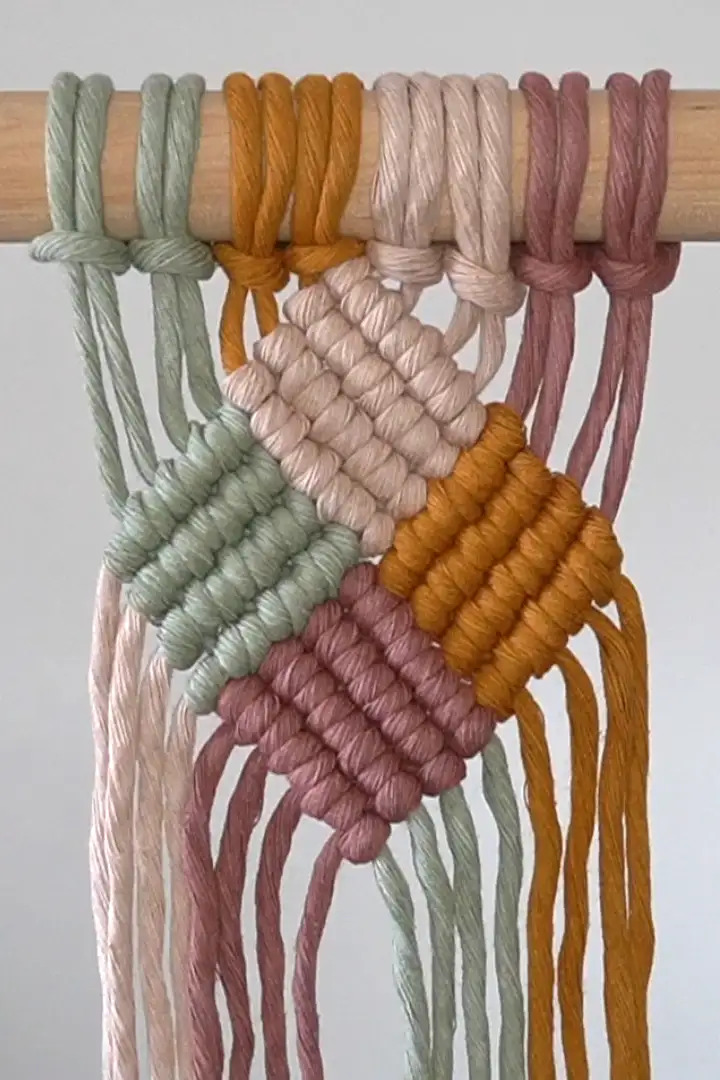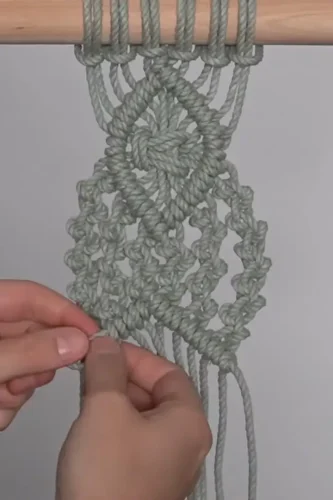New Macrame Ideas, DIY Macrame – Colour Block Pattern
Table of Contents
New Macrame Ideas, DIY Macrame – Colour Block Pattern


Materials:
– 5mm Recycled String (Colours: Sage, Mustard, Bisque, Rose Tea)
Let’s get started.
Cut 2 pieces of 5mm string, in four different colours, each piece is 6ft in length. I’m using sage, mustard, bisque and rose tea. Attach them to your dowel using Lark’s Head Knots as I’ve done here. To create the pattern we will use the double half hitch knot. If you are unfamiliar with this knot please see the description for a more in-depth tutorial.
Use the inner left cord as your filler cord and tie 4 dhhks working down and to the right. Use the remaining mustard cords as your filler cord and tie 3 more rows of 4 dhhks. Tie the knots a little further down the mustard cord with each row to create a diamond shape.Use the bisque cords as your filler cords and the sage cords as your working cords and tie 4 rows of 4 dhhks working down and to the left.
Use the rose tea cords as your filler cord and the mustard cords as your working cords and tie 4 rows of 4 dhhks working down and to the left.
Use the sage cords as your filler cord and the rose tea cords as your working cords and tie 4 rows of 4 dhhks working down and to the right.

Tutorial Video:
The ancient art of macrame has been used in a variety of ways for centuries. The first known examples of macrame are in the carvings of the Babylonians and Assyrians. The ancient art spread to Europe via North Africa. In the 12th century, the Arabs brought macrame to Spain and the craft was rediscovered during the Renaissance. In Victorian England, the art was so popular that Queen Mary taught macrame classes to her ladies-in-waiting. The Victorians admired the intricate knotwork in the home, and there are several beautiful examples to admire in their architecture.
Although silk cord is the most traditional and most expensive option for macrame, it can be hard to find, and it is expensive and hard to work with. There are other materials available that will help you create the most beautiful macrame pieces. For example, you can choose synthetic cords that are strong, weather-resistant, and usually come in bright colors. Nylon and rayon are both silky, but tend to slip during knotting. Synthetics are often combined with natural fibres to give them extra strength and durability.
You can find all kinds of cords to use in macrame projects. One of the most important things to remember when starting out is to buy enough cord. You will need five to six times the amount you intend to use for your project. You may want to leave some extra cord for fringe. This way, you can trim the cord down later. Many beginners have trouble making neat, even knots. To solve this problem, keep tension and balance your knots. As you practice, you will become more experienced and more able to judge how much you need.
You can dye macrame to match your color scheme. To do this, you need to soak macrame cord in fabric dye and let it soak in the solution for 20 to 40 minutes. Make sure you handle the macrame cord gently because you don’t want to damage it. Afterwards, you should be patient and wait until it dries completely. The dye will take a while, so set aside some time for drying.
In addition to using rope, you can also use wooden handles to hang macrame projects. In addition to wood, you can also use jute, hemp, or jute to add a rustic look. The best material to use for macrame is natural fibers like hemp and jute, so you can opt for the material you prefer. Alternatively, you can buy macrame accessories or decorative pieces. All you need to do is look for a pattern that matches your preference.
You can also hang macrame on a wall. This method requires patience and the skill to tie half hitch knots. Its textured edges make it a great choice for a casual look and can be machine-washed at 86 degrees. However, it should not be washed in a washing machine or used as a curtain. Moreover, you can hang your finished macrame project in a dry place.
If you are looking for a bag, you can choose from many options. You can use jute, hemp, and leather cord. In addition to jute, you can also use a variety of other materials. A macrame purse can be easily cleaned. You can simply machine-wash the material at 86 degrees and hang it to dry. Then, you can decorate it with beads, tassels, and other accessories.
Aside from macrame wall hangings, macrame can also be used to make plant hangers and wall hangings. It is an excellent way to add texture to your walls and add a touch of color to your décor. If you are a beginner, you should stick to simple projects for your first project and avoid complicated ones. If you have a lot of time, try making a small, inexpensive mobile. Aside from a wall hanging, you can also make a mobile.
A macrame project can be a very simple and inexpensive way to express your creativity. A basic sunscreen bracelet can be made with just a few cords and a knot. You can also create a fun macrame mobile by stringing colorful glass jars and making a simple tree from it. Once you’ve mastered the art of macrame, you can turn anything into a macrame project.
DIY Macrame Tutorial – Coloured Flower


Materials:
-16 ft of 4mm String (Colour: Bisque)
-36 ft of 4mm String (Colour: Vintage Blue)
Tutorial Video:




